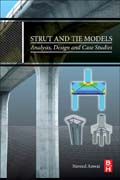
Strut and Tie Models: Analysis and Design presents a systematic and consistent approach to the application of the STM to almost all types of members using the arbitrary distinction between a D and a B region. Strut and tie modeling provides design engineers with a flexible and intuitive option for designing structures or portions that are heavily influenced by shear forces. The book also demonstrates how strut and tie modeling and finite element methods are not mutually exclusive but rather complementary and supportive. The book's four part treatment starts with an overview of structural analysis and strut and tie models (STM). This is quickly followed by relevant topics such as: loads and load paths through members plus case studies, and formalization of strut and tie models. Applications of STM are then explained in detail along with extracting STM through FEM. In addition, the book will include solved examples and mobile apps. Includes moment curvature analysis, interaction diagrams and reinforcement design and stress analysis for structural cross sectionsIncludes modeling tools and computational methods for cross-sections for stress distribution and stress calculationsFeatures many illustrations, schematics, diagrams and line drawingsIncludes author-developed computer-based apps to be used in conjunction with the practical applications presented in the bookCovers both the Eurocodes and American Concrete Institute codes, which are two major, widely-used building design code documents in the world according to researchgate.net INDICE: Introduction Overview of Structural Analysis Overview of Strut and Tie Models (STM) Part A: Loads and Load Paths through Members A.1 Principle of Steel Bridges A.2 Steel Truss Bridges (Plus Case Studies) A.3 Steel girder draw bridge (Plus Case Studies) A.4 Steel truss railway bridge (Plus Case Studies) Part B: Formalization of Strut and Tie Models (STM) B.1 Overview of Truss Analogy B.2 Definition of STM B.3 Struts. Ties, Nodes B.4 Principles of constructing STM B.5 Manual analysis of STM B.6 Computer Aided Analysis of STM B.7 Interpreting STM Results B.8 Limitations of STM Part C: Application of STM C.1 Overview C.2 Beams and Transfer Girders C.2 Transfer Slabs C.3 Corbels, Brackets C.4 Joints C.5 Walls C.6 Footings and Pipe Caps C.7 Bridge Bents C.8 Pre-stressed Members C.9 Special Applications Part D: Extracting STM through FEM D.1 Principle of STM extraction D.2 From Membrane and Shell Models D.3 From Solid Models D.4 Non-linear modeling and STM
- ISBN: 978-0-12-804705-7
- Editorial: Butterworth-Heinemann
- Encuadernacion: Rústica
- Páginas: 352
- Fecha Publicación: 01/09/2017
- Nº Volúmenes: 1
- Idioma: Inglés
